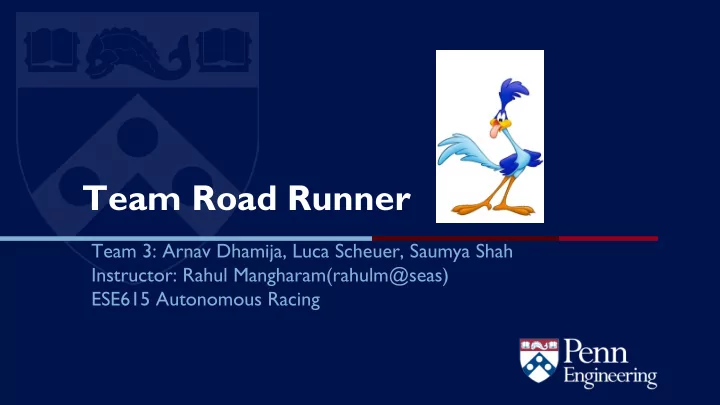

Team Road Runner Team 3: Arnav Dhamija, Luca Scheuer, Saumya Shah Instructor: Rahul Mangharam(rahulm@seas) ESE615 Autonomous Racing
Content 1. Milestone II approach Pure pursuit - CMAES - Splines - II. Milestone III approach RRT + Pure Pursuit - Advancements - III. Milestone IV approach MPC - Lane switching - IV. Miscellaneous
Milestone 2 approach
Optimal Trajectory ● CMAES for trajectory generation Sparsely sampled centerline points for CMAES initialization ○ Polar constraints for CMA-ES solver ○ Solves for R i , θ i ■ No box transformations involved ■ Simplified constraints to bounds as required ■ Regularized spline fit on the sampled points ○ Fitness calculated as time to complete the loop with curvature ○ dependent velocity profile (leads to approx. minimum curvature trajectory) Regularized spline on final solution sampled for 500 points ○ 4
Optimal Trajectory CMAES trajectory vs Centerline Fitness curve vs optimization iters 5
Optimal Trajectory ● Pure Pursuit ○ Used Pure Pursuit with lookahead to follow the way points at full speed ○ Cons: No drift control 6
Milestone 2 7
Milestone 3 approach
RRT* ➢ RRT* was used for Milestone 3 with following features: Angle Constraints in steering function ○ Velocity calculated based on path length and speed ○ Early stopping - direct to goal ○ Path Freezing until collision detection or completion ○ Occ-grid dilation ○ ➢ Pure pursuit used to set goals for RRT* with some lookahead ➢ Issues with tracking, single-threaded approach 9
Result: 10
Milestone 4 approach
Overall idea ➢ Trajectory Selection Local Trajectories Generation ○ Local Path selection to track Global Path ○ ➢ MPC controller Reference Tracking controller ○ ➢ Lane Switching 12
Trajectory Selection ➢ Global Path CMA-ES trajectory + Alternate parallel lanes ○ ➢ Local Paths Generated constant curvature paths offline ○ Drift minimal curves with fixed velocity ○ Mini-HRHC paths 13
Trajectory Selection ➢ Path selection Selected the local reference path which maximizes the ○ objective Objective: ➢ Closeness to the global path + maximizing progress + incremental index (prevents moving (promotes going far (prevents reversal) far from global) along global) 14
MPC Controller ➢ Cost function Quadratic Cost ○ Large state costs (x,y; orientation not penalized) ○ Small input costs (higher for orientation, near zero for v) ○ Desired input held at a constant high speed ■ 15
MPC Constraints Dynamics of System ➢ Kinematic Model with x,y, ϴ ○ Linearized using Forward Euler Discretization (proved to be accurate if t ⋍ 200ms) ○ 16
MPC Constraints Steering vs Velocity Constraints ➢ Non-linear, but kind of close ○ Set to infinity in final race parameters ○ 17
Lane Changing backup ➢ Why? ○ Current CMA-ES trajectory might be blocked by opponent ➢ Our solution ○ Keep 5 backup concentric paths which serve as lanes and switch tracking them on the fly ○ Use lookahead for collision on current path 18
Other features ➢ Multithreading Have a detached thread publishing on /drive in an infinite loop at ○ 50Hz Use remainder of previous MPC solution outputs before current ○ MPC finishes solving Anytime Algorithm! ■ ➢ Visualizations Car positions as calculated by QP solution ○ Lane changes ○ 19
Results 20
Miscellaneous
Testing Methodology ➢ First test in 1-P simulator when running in debugger ○ Find edge cases and fix them ○ Use pose estimate and place vehicle in different positions ○ Add obstacles to course ➢ Run in 2-P Gym simulator ○ Use gdb attach if problems show up ➢ Race against our old agents ○ Issues with passing slower agents or unpredictable ones 22
Cutting Room Floor - Unused Material ➢ Prediction ○ Using Gaussian Process model trained over a bundle of trajectories generated using CMA-ES ○ Predicts dx/dt and dy/dt in real time for half the loop ○ Shortcoming: needs several priors about opponent trajectory, model size > 1.5GB, difficult to incorporate with planner ➢ Half space constraints for MPC ○ Couldn’t figure out a suitable formulation to use for collision prevention 23
Cutting Room Floor - Unused Material ➢ RRT* as MPC Backup ○ Used regularized cubic splines to interpolate between trajectory points for smoothing ○ Applied randomized shortcutting algorithm to reduce path length safely ○ Issues: Couldn’t get MPC to track the trajectory reliably 24
Cutting Room Floor - Unused Material Red - Splined RRT*, Purple - Shortcut & Splined Trajectories sampled for training a Gaussian Process RRT* 25
Cutting Room Floor - Unused Material 26
Learning Experiences • (Dynamically feasible) RRT* is hard to get right • Start simple before complicated solutions • Use classes and objects liberally for C++ codebase • Always use run with GDB when trying new things! • Using visualizations helps a lot with debugging • Learn to use the right tool for programming and collaborating • Unit tests would have saved a LOT of time • “Brilliance is knowing when to stop” - _anon (2020) 27
Something Silly 28
Acknowledgements Thank you TAs for all your hard work for making this learning experience possible and Prof. Rahul for this opportunity. 29
"We may win and we may lose, but we will never be defeated." - _anon (2020) THANK YOU
“Questions, Comments, and Concerns?” 31
References MPC Lecture slides: 1. https://docs.google.com/presentation/d/1TcleCBkHEoWMcvqR1ykKvhhl7tIENiC6Xy_UVFI3 ppI/edit#slide=id.p30 2. Alexander Domahidi Alexander Liniger and Manfred Morari. Optimization-based autonomous racing of 1:43 Scale rc cars. November 2017 3. Thomas Lipp and Stephen Boyd. Minimum-time speed optimisation over a fixed path.International Journalof Control, 87(6):1297–1311, 2014 4. Achin Jain Joseph Auckley Kim Luong Matthew O’Kelly, Hongrui Zheng and Rahul Mangharam. Tech report:Tunercar: A superoptimization toolchain for autonomous racing. September 2019. 5. Goli, S. A., Far, B. H., & Fapojuwo, A. O. (2018). Vehicle Trajectory Prediction with Gaussian Process Regression in Connected Vehicle Environment. IEEE Intelligent Vehicles Symposium, Proceedings, 2018-June(Iv), 550–555. https://doi.org/10.1109/IVS.2018.8500614 6. Hauser, K., & Ng-Thow-Hing, V. (2010). Fast smoothing of manipulator trajectories using optimal bounded-acceleration shortcuts. Proceedings - IEEE International Conference on Robotics and Automation, 2493–2498. https://doi.org/10.1109/ROBOT.2010.5509683 32
Recommend
More recommend